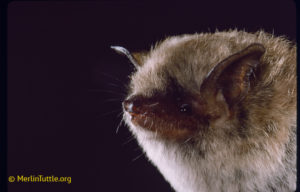With the growing realization that the age of cheap and available petroleum is waning, development of renewable energy alternatives is gaining momentum. Wind power is growing more rapidly than any other energy source in the United States, although it currently provides a very small percentage of total power.
In 2007 alone, more than 5,000 megawatts of new wind power capacity were installed nationwide. California’s renewable energy standard requires that 20 percent of the electricity sold in the state by 2010 be derived from renewable energy resources, which will include wind power. The renewable target may even be increased to meet California’s greenhouse gas emission goals.
Unfortunately, wind turbines can exact a fatal toll on birds. And according to a 2007 study by the National Research Council, birds may not be the only victims; bats may experience even greater mortality from land-based wind turbines. Large bat kills have been reported at facilities in West Virginia, Pennsylvania, and Tennessee. A recent review of nationwide wind resource projects found bat mortality to be highly variable, concentrated in the late summer/fall, and occurring mostly on low wind nights.
Bats are the primary predators of night-flying insects, and play an important role in reducing agriculture and forest pests. They also help control mosquitoes that transmit diseases such as West Nile Virus. Since bats are generally long-lived, and have low reproductive rates, anything that consistently increases mortality could have a large effect on bat populations. There are 25 known species of bats in California. Populations of a number of these are in decline, primarily due to habitat loss.
So what do we know about effects of wind turbines on bats in California, and especially in the Bay Area? Surprisingly little, it turns out. Most of the studies have focused on fatalities of large birds, and those studies are not good at identifying or quantifying bat impacts. The surveys occur too infrequently–bat carcasses may be removed by scavengers between samples or decompose too rapidly to be detected, and the transects are typically too widely spaced to allow detection of small animals. Monitoring the bats’ movements directly is also difficult.
The uncertainty regarding the possible effects of wind farms is compounded by the fact that we don’t know much about bats in general, their migratory patterns, populations, or for some species their basic life history.
However, our knowledge about bat mortalities at wind farms may soon improve because the California Energy Commission has recently released guidelines for siting wind farms, and monitoring their performance post-construction. To the extent these voluntary guidelines are adopted and implemented by counties (which typically handle permitting for wind farms), standardized monitoring data specifically for bats will become available. If those studies indicate significant bat mortalities, the ability to modify existing wind farms may be limited, but the results could influence siting and operations for new facilities. Currently available anecdotal data suggest that bats may be more affected by the new larger, higher turbines than the lower, smaller turbines installed in the 1980s. If this hypothesis is supported by the improved monitoring data, the repowering effort underway at Altamont pass (replacing the older, lower wind turbines with more modern machines with blades more than 200 ft. above the ground) may be beneficial to raptor species, but could pose an increased risk to bats.
We also don’t know much about the mechanism that causes bat mortality. A recent study from Alberta, Canada, suggests that the bats may be subjected to barotrauma –injuries due to a change in atmospheric pressure. It appears that the moving blades of the wind turbines create a localized drop in air pressure. The lungs of bats flying through the low pressure area expand quite rapidly, which bursts blood vessels and kills the bats. This theory is consistent with the researchers’ observations that very few of the bat carcasses below wind turbines exhibit external injuries. Previously, researchers had hypothesized that bat mortalities were caused by the high-frequency noise from the turbines’ gears and blades disrupting the bats’ echolocation systems.
Learn more about bat population and windfarm dangers at the USGS’s page on bat fatalities or at the website of the Bats and Wind Energy Cooperative.




